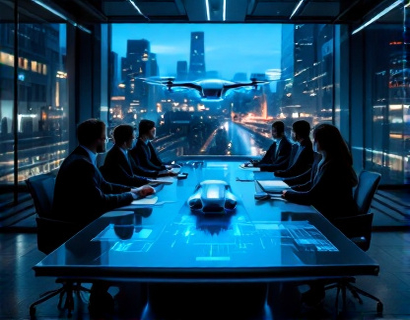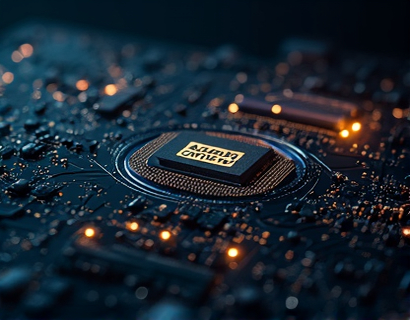Next-Gen Aerospace Innovations: Transforming Efficiency and Safety for Industry Leaders
The aerospace industry stands at the forefront of technological innovation, driven by the relentless pursuit of efficiency, safety, and performance. Recent advancements have revolutionized both aviation and space exploration, offering industry professionals and visionaries a glimpse into a future where the boundaries of what's possible are continually pushed. This article delves into the latest technological breakthroughs that are reshaping the aerospace landscape, providing a comprehensive overview for professionals and innovators alike.
Advanced Materials and Structures
One of the most significant areas of innovation in aerospace is the development of advanced materials and structures. Traditional materials like aluminum are being replaced by lighter, stronger, and more durable alternatives. Composite materials, such as carbon fiber reinforced polymers, are becoming increasingly prevalent due to their exceptional strength-to-weight ratio. These materials not only reduce the overall weight of aircraft and spacecraft but also enhance structural integrity, leading to improved fuel efficiency and extended operational lifespans.
Additionally, the use of additive manufacturing, or 3D printing, is transforming the way aerospace components are produced. This technology allows for the creation of complex geometries that are impossible to achieve with conventional manufacturing methods. It reduces material waste, shortens production times, and enables the production of lightweight, high-performance parts. For instance, NASA has successfully tested 3D-printed rocket engine parts, demonstrating the potential for more efficient and cost-effective manufacturing processes.
Electric and Hybrid Propulsion Systems
The shift towards electric and hybrid propulsion systems represents a paradigm shift in aerospace technology. Electric motors offer several advantages over traditional jet engines, including higher efficiency, lower emissions, and reduced noise levels. For short-range flights, electric propulsion systems are particularly promising. Companies like Eviation are developing all-electric aircraft, such as the Alice, which is designed to carry six passengers over distances of up to 650 kilometers.
Hybrid propulsion systems, which combine electric and conventional engines, are also gaining traction. These systems can optimize fuel consumption and reduce emissions by using electric motors during takeoff and landing, when jets consume the most fuel. Airbus has been at the forefront of this technology with its E-Fan X project, which aims to demonstrate the feasibility of hybrid-electric propulsion in commercial aviation.
Autonomous Systems and AI
Autonomous systems and artificial intelligence (AI) are revolutionizing the aerospace industry by enhancing safety, efficiency, and operational capabilities. Autonomous drones, or unmanned aerial vehicles (UAVs), are already being used for a variety of applications, from surveillance and inspection to cargo transport. These drones can operate in hazardous environments, reducing the risk to human pilots and crew.
AI plays a crucial role in the development of autonomous systems by enabling real-time decision-making and adaptive control. Machine learning algorithms can analyze vast amounts of data to predict maintenance needs, optimize flight paths, and improve overall system performance. For example, Boeing has integrated AI into its flight testing processes, using predictive analytics to identify potential issues before they become critical.
Advanced Avionics and Flight Control Systems
Advancements in avionics and flight control systems are enhancing the safety and efficiency of modern aircraft. Next-generation avionics incorporate sophisticated sensors, high-performance computers, and advanced software to provide pilots with real-time data and automated control functions. These systems can monitor multiple parameters simultaneously, from weather conditions to aircraft health, ensuring optimal performance and safety.
Fly-by-wire systems, which use electronic signals instead of mechanical linkages, have become standard in commercial aviation. These systems offer greater precision and reliability, reducing the likelihood of human error. Additionally, the integration of artificial intelligence in flight control systems allows for more intuitive and responsive aircraft behavior, further enhancing the flying experience.
Sustainable Aviation Fuels
Sustainability is a critical concern in the aerospace industry, and the development of sustainable aviation fuels (SAFs) is a key area of focus. SAFs are derived from renewable resources and can significantly reduce greenhouse gas emissions compared to traditional jet fuel. These fuels can be blended with conventional fuel without modifying existing aircraft engines, making them a practical and immediate solution.
Companies like Shell and Airbus are collaborating on projects to produce and commercialize SAFs. The International Air Transport Association (IATA) has set a target for 2 billion passengers to be flown on SAF by 2030, highlighting the industry's commitment to reducing its environmental impact. As the production and availability of SAFs increase, their adoption is expected to grow, contributing to a more sustainable future for aviation.
Space Exploration Innovations
The aerospace industry is not only transforming commercial aviation but also advancing space exploration. Innovations in rocket technology, propulsion systems, and spacecraft design are making space travel more accessible and cost-effective. Reusable rockets, such as those developed by SpaceX, are revolutionizing launch operations by significantly reducing the cost of access to space.
In-orbit assembly and manufacturing are also becoming viable options, allowing for the construction of larger and more complex structures in space. This capability opens up new possibilities for building space stations, satellites, and even lunar or Mars bases. NASA's Lunar Gateway project, a modular orbiting station, exemplifies this approach, aiming to serve as a base for future missions to the Moon and beyond.
Enhanced Safety Features
Safety remains a top priority in aerospace engineering, and recent innovations have led to significant improvements in this area. Advanced collision avoidance systems use a combination of sensors and AI to detect and prevent potential collisions, both in the air and in space. These systems can automatically adjust flight paths to avoid hazards, reducing the risk of accidents.
Additionally, the use of advanced materials and structural designs enhances the overall safety of aircraft and spacecraft. For example, the development of self-healing materials that can repair minor damage autonomously can extend the lifespan of aerospace vehicles and improve their reliability. These innovations not only protect passengers and crew but also reduce maintenance costs and downtime.
Conclusion
The aerospace industry is on the cusp of a new era of innovation, driven by advancements in materials, propulsion, autonomous systems, and sustainability. These technologies are not only enhancing the efficiency and safety of aviation and space exploration but also opening up new frontiers for human endeavor. As industry leaders continue to push the boundaries of what's possible, the future of aerospace engineering looks brighter and more promising than ever.










































